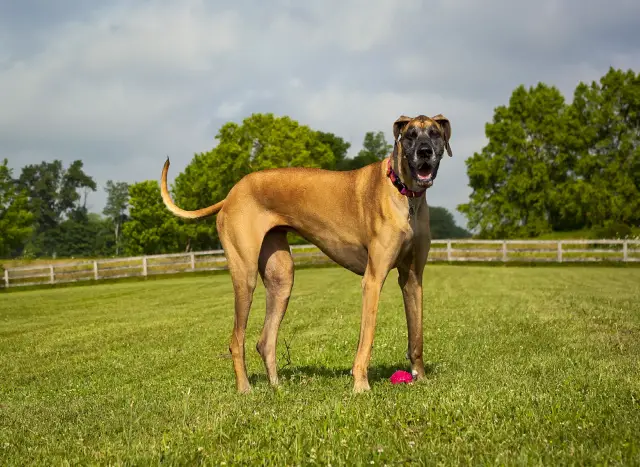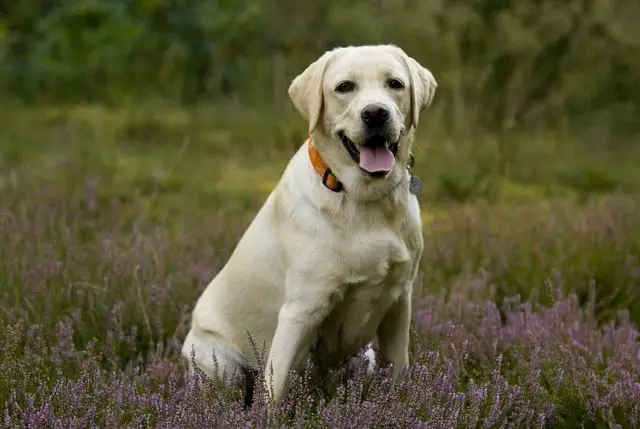You may or may not have heard the term ‘deep-chested’ dog, but knowing whether your dog falls into this group, can radically aid in their future wellbeing.
Deep-chested dogs usually have large chests that come down to their elbows and are oval in shape. Breeds such are Greyhounds and Great Danes are examples of deep-chested dogs.
Deep-chested dogs (although typically athletic) are prone to respiratory conditions such as Gastric Dilation and Volvulus (GDV). Knowing how to prevent these conditions and remaining attentive to behavioral changes can help avoid future challenges.
Check out our list of deep chested dogs as well as all you need to know about these dogs here.

Related: Barrel Vs. Deep Chested Dogs (Examples Included) | Barrel Chested Dog Breeds Explained
Deep Chested Dog Breeds
There are a variety of deep-chested dog breeds. While most of these breeds are medium to large- dog breeds, smaller, deep-chested dogs also exist.
Most deep-chest dogs are active, athletic breeds known for their speedy running and exceptional endurance. Several of these breeds have been bred specifically for working or hunting.
Their oval-shaped chests give them additional lung capacity and fuller, deeper breathing. This provides them with the oxygen and energy needed to handle vigorous activities.
How Do I Know if My Dog is Deep-Chested?
A deep-chested dog is typically easy to spot. Carefully look at your dog’s chest area, which runs from its neck down to its stomach.
Ask yourself the following questions:
- Does your dog’s chest area (thoracic cavity) fall as low or lower than the elbows of their forelegs?
- When examining your dog from the front, does their chest appear oval-shaped?
- When examining your dog from the side, does their stomach look higher than the bottom of their rib cage?
- Does their chest area (rib cage) appear taller and narrower than it is wide?
If you answer a resounding ‘YES’ to all the questions above – you own a deep-chested dog!
A Quick List of Some Common Deep-Chested Breeds
If you are still unsure whether your dog is deep-chested or not, here is a non-exhaustive list of some of the more common deep-chested small and medium to large dog breeds.
Medium & Large Deep-Chested Dog Breeds
- Australian Shepherd
- Doberman Pincher
- Great Dane
- Greyhound
- Golden Doodle
- Labrador
- Irish / Gordon Settler
- Irish Wolfhound
- Newfoundland
- Rottweiler
- Old English Sheep Dog
- Saint Bernard
- Standard Poodle
- Weimaraner
- Akita
- Boxer
Small Deep-Chested Dog Breeds
- Basset Hound
- Daschunds
Health Issues to Look Out for in Deep-Chested Dogs

No dog breed comes with zero health risks. Each breed has its unique array of advantages and disadvantages.
The secret is educating yourself on your dog’s breed and their family history of predisposed diseases. Knowing what they are prone to and what warning signs to look out for can aid in preventing complications down the line.
When it comes to deep-chested dogs, respiratory problems should be your primary concern. Here are some details of the main respiratory issues you may encounter and how to treat or avoid them.
Gastric Dilation (GD) and Gastric Dilation with Volvulus (GDV)
Gastric Dilation and Volvulus is a potentially life-threatening disorder if left untreated. This disorder occurs when a dog’s stomach fills with gas causing it to dilate or bloat.
Gastric Dilation can develop into GDV when the gas build-up is so significant that the stomach twists or rotates. This usually causes both the exit and entrance of the stomach to block, cutting off circulation to the digestive organs.
The bloating of the stomach also creates pressure on the dog’s diaphragm. This is hugely uncomfortable and often triggers respiratory distress.
Why Do Gastric Dilation and Volvulus Occur?
The actual cause is unknown, but research and veterinary advice suggest that the condition is related to how much air a dog swallows when eating. Typically, more air is engulfed when dogs eat or drink too fast.
Which Dogs are Prone to GDV and Why?
Typically, larger deep-chested dogs are more prone to GD and GDV due to the larger and deeper size of their chests. Their bigger size cavity allows for easier stomach expansion and provides more room to allow any stomach rotation or twisting.
Male dogs are more prone to the condition than female dogs. Moreover, smaller, more elderly dogs (7 years or older) are also known to experience bloat, but fortunately, the bloat does not usually progress to Volvulus.
The Great Dane, St Bernard, and Weimaraner breeds are three of the most GDV susceptible dogs.
Is There a Treatment?
The symptoms of GD and GDV are similar, and it is hard to tell the two apart unless an x-ray or further testing is performed.
Usually, pain medication and IV fluids are given to decrease any shock or discomfort.
A quick procedure can also remove some of the excess gas from their stomach. Unfortunately, hospitalization and operations are necessary in severe cases to help untwist the stomach.
Can You Prevent GD or GDV in Deep-Chested Dogs?
Fortunately, knowing that your dog is deep-chested provides you the opportunity to make the necessary exercise, diet, and medical changes to prevent the development of future respiratory conditions.
Diet Considerations
My dog is an excellent example of a dog that eats too quickly. It does not matter when or how much food I place in front of him – he will wolf it down, almost choking before I can walk away.
If you own a deep-chested dog, ignoring this behavior will not do them any favors. Eating fast increases their risk of swallowing too much air, which can lead to bloat.
Slow Your Dog’s Eating and Drinking Down
Consider s-l-o-w-i-n-g down your dog’s eating at much as possible. If you own more than one dog, feed them separately to reduce competitive eating.
There are superb puzzle dog bowl options available that are made with the intention of slowing down your dog’s eating.
This dog bowl is an excellent, highly rated puzzle bowl that claims to reduce eating speeds up to ten times: Outward Hound Fun Feeder Slo Bowl.
Several dog experts have also suggested scatter feeding rather than bowl feeding. This technique increases your dog’s feed time and will appeal to many dogs’ hunting tendencies. Scatter the dry kibble on the lawn and let your dog forage.
To slow your dog’s drinking down, consider water bowl options that enable your dog to drink small quantities at a time, such as the UPSKY Dog Bowl Dog Water Bowl.
Offer Reduced Portions
It is better to provide your dog with smaller meals throughout the day instead of one meal daily. If you don’t have the time to feed your dog multiple meals, at best, up mealtimes to mornings and evenings.
Ingesting large amounts of food or water can increase their risk of developing respiratory issues. GDV typically occurs two or three hours after dogs eat a large meal.
Offering frequent smaller meals will leave your dog feeling less hungry and will lessen the likelihood of their overeating.
Dogs that weigh over 100 pounds have a 20% greater risk of developing bloat. Ironically, their risk also increases if they are underweight. It is imperative to monitor your deep-chested dog’s diet, exercise, and food quantity.
Food Type
Try feeding your dog dry dog food only. If you want to add something tasty to their kibble, add a small amount of calcium-rich meat.
Your deep-chested dog should not eat moistened dog food, especially if citric acid has been added to the food as a preservative. This will only increase their risk of developing bloat.
Exercise Considerations
For the most part, dogs need and enjoy a daily exercise routine. Deep-chested dogs are commonly athletic, and many of these breeds require vigorous or lengthy exercise schedules.
Carefully consider when in the day you decide to take your furry friend exercising, and do not let their lovable persuasive eyes convince you otherwise.
Avoid strenuous activity or exercise before or after a dog’s meal, as this has been shown to potentially trigger GV episodes. Schedule runs or walks for a couple of hours before or after a meal to be safe.
A Couple of Health Considerations and Recommendations
I promise not to bore you with lists of recommendations, but I do feel that there are one or two final suggestions I must share. I believe prevention is always better than future upset and costly treatments.
Lookout for Behavior Changes
The better your doggy-human relationship and the more attentive you are to their behaviors, the easier it will be to pick up any signs of discomfort.
If you notice changes and are unsure if they are GD related, always check with a veterinarian. GD symptoms can develop quickly, and treating the condition quickly is essential.
GD or GDV Symptoms
Your dog’s abdomen may look distended; they may dry heave, pant, or look restless and anxious. You may also notice that they are having difficulty breathing. Their heartbeat may raise, and in severe cases, they may drool or foam from the mouth.
Monitor Their Stress Levels
Research has indicated that stress may be a contributing factor to GDV. If your dog has a nervous or anxious temperament, this can increase their risk.
Try to notice what is triggering their anxiety, or contact your veterinarian. A veterinarian will usually suggest medications or techniques for lessening your dog’s fear and unease.
Prophylactic Gastropexy Surgery
If your dog has a family history of GDV and the risk of developing the condition is high, you may consider questioning your veterinarian about Prophylactic gastropexy surgery.
This surgery is minimally invasive and is typically done when your dog is spayed or neutered.
It has successfully aided in preventing GDV in several high-risk dogs. Although the operation will not prevent GD, it will stop it from progressing to GDV and becoming life-threatening.
Dog Insurance
If you know your dog is high-risk, investing in pet insurance can significantly reduce your anxiety over possible future veterinarian costs. Surgery and treatment costs for GDV can quickly escalate. There are several insurance companies available, but I would recommend first chatting and asking for advice on options from an experienced veterinarian.
Related Reading:
- What Age Can Labrador Puppies Go Up and Down Stairs?
- Signs You’re Underfeeding Your Puppy
- 8 Ways to Keep Your Dog Cool on Hot Summer Nights
- Signs You’re Overfeeding Your Dog
- Do Dogs Get Sad Changing Owners Or Being Rehomed?
- 9 Dog-Friendly Camping Spots Near Salt Lake City and Provo
- Is Rice OK for Dogs to Eat? | Pros and Cons of Rice
- Is It OK for a Dog to Wear a Harness All Day and Night?
- My Dog Ate My Dentures (False Teeth) | Is The Dog OK?


